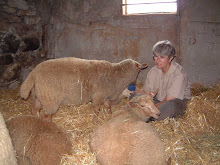Every week we all collect our mail and there they are... grocery store flyers with their bright colours, bold print, enticing photos and even more enticing prices... especially those on the front page. Then we go to the farmer's markets and ...What is with the prices?! Actually those prices at the Farmer's Markets are probably still lower than they should be based on cost of production.
Grocery stores are trying to entice you into the store with their flyers and offering big discounts on a selected number of items to get you in there with the hope that once you are in the store you will buy a whole lot more where the price is marked up substantially. Many items are sold at or below cost to entice you into the store. These are called loss leaders. "A loss leader, or simply a leader,is a product sold at a low price, at or below its market cost to stimulate other sales of more profitable goods or services." - Wikepedia Typical loss leaders include perishable items such as milk and eggs.
The prices that you see in the flyers and even the prices for selected items that are never in the flyers do not reflect the true cost of these items. However, even grocery stores who sell in huge volumes are scrambling for the profit dollar.
No matter what you call it be it a "Cheap Food Policy" or something else, the reality is the proportion of household income spent on food has steadily declined since the end of the second world war to the point where the average household in Canada spends less than 10% of their disposable income on food compared to over twice that back at its peak in the 1930s. Only the United States spends less. (http://wsm.wsu.edu/researcher/WSMaug11_billions.pdf)
The price for food has not even kept pace with inflation. For example, the price of eggs in 1954, i.e. the year I was born, was 76 cents a dozen. What would that be in 2013 dollars just taking into account inflation? The answer is $6.51. So why are the stores often selling for less than $3 a dozen? By the way you can do the same with all basic food commodities with the same result.
I recently took a farm budgeting course and we did a back of the envelope calculation as to the true cost of producing a dozen eggs in a free range non-confinement system that actually included labour costs (and we are not talking big salaries but marginally above minimum wage). The cost of a dozen eggs was $6 a dozen.
And consumers wonder why can't farmers make a go of it unless they automate and raise thousands of birds. It is because you as consumers have been handed a bill of goods as to the true cost of food. Not only is food underpriced in this country but it is also undervalued.
Public policy advocates and animal rights activists petition the government to change policies and regulations, to outlaw large "factory" farms and return to the family farm. However they fail to recognize the most powerful tool of change, that is the consumer dollar. If you cease to buy these products, they will cease to exist. If you want to see an end to practices that you feel compromise the health and welfare of animals and the environment support farmers that follow the practices you want to see. However you MUST be prepared to pay to the true cost for food. You cannot expect farmers to subsize your food budget for the sake of your values.
If you want to take a position on food production (and I hope you do), do so but be willingly pay the true price for food.
Later,
Laurie
Wednesday, February 27, 2013
Grocery store flyers and the fallacy of food costs
Subscribe to:
Post Comments (Atom)


No comments:
Post a Comment